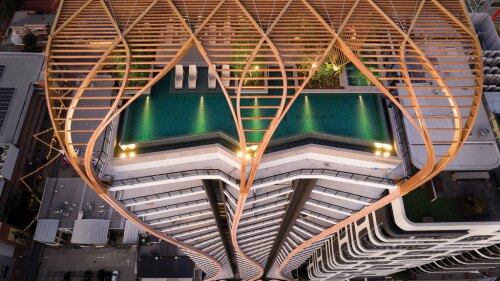Firms led by principals under the age of 50 provide a glimpse into the future of architecture.
All architecture is a dialogue with the past, as designers seek ways to say something new while engaging with existing contexts, layers of history, and the conventional needs of building users. Each generation of architects must contend with these issues, embracing, extending, and breaking away from the strategies of
its predecessors.
The following ten projects—all completed over the past five years—represent the work of firms led by principals in their 30s and 40s. Each project shows a different approach to navigating past and present, including a college building in Estonia that incorporates a ghostly echo of a long-lost stock exchange; a monastery-turned-performance-hall that displays archaeological relics beneath audience seating; a sinuous take on the classic skyscraper form; multifamily residences with atypical approaches to common components such as balconies and sun shades; and a gleaming, dark-blue gemlike museum..
Ron Nyren is a freelance architecture, urban design, and real estate writer based in the San Francisco Bay area.
Experience everything the Urban Land Institute offers! By joining ULI, you receive a free print edition of Urban Land Magazine, exclusive members-only content, significant discounts on events, workshops, and publications, and more.
Receive updates on similar articles from Urban Land magazine. Click here to sign up for our FREE weekly e-mail newsletter.
1. Absolute Towers
Mississauga, Ontario, Canada
In an unusual move for private developers, Toronto-based Fernbrook Homes and Cityzen Development Group staged an international design competition in 2006 to design the fourth of five towers in their master-planned condominium community in Mississauga, a suburb of Toronto. The winning design, by Beijing-based MAD, gives the classic rectilinear skyscraper a more organic form. MAD created a 56-story tower in which the elliptical floor plates are identical in size, but each one is rotated a few degrees in relation to the one below it to create a distinctive profile. Continuous balconies ring the floors.
Units in the curvy tower—dubbed “Marilyn Monroe” by locals—sold out so rapidly that the developers asked MAD to design the community’s fifth tower, which is slightly shorter at 50 stories, along similar lines. Completed in 2012, the two buildings serve as a landmark at the intersection of two major thoroughfares. MAD was founded by Beijing-born Ma Yansong in 2004.
2. East Village
Austin, Texas
Thomas Bercy and Calvin Chen founded Austin-based Bercy Chen Studio in 2001 as an architecture firm with design-build capabilities and an interest in turning green design strategies into aesthetic elements. One example is East Village, a mixed-use building. Colorful steel panels on the south and west facades serve as guardrails for the residential balconies and shield units from the hot Texas sun. The fourth floor incorporates two accessible green roofs with views of downtown.
Completed in 2010 for local developer Esperanza Development, East Village comprises 11 commercial units and 20 residential condominiums, of which four are set aside as affordable housing. Configuring the ground floor as many small commercial units instead of a single large one allowed local tenants to lease space for small businesses such as galleries, boutiques, coffee shops, and hair salons. A short walk from downtown and public transit, East Village is part of Austin’s East 11th Street revitalization district.
3. Jujuy Redux
Rosario, Santa Fe Province, Argentina
Brothers Marcelo and Maxi Spina grew up in Rosario, one of Argentina’s most populous cities. Although both run Los Angeles–based architectural practices—Marcelo founded P-A-T-T-E-R-N-S in 1999 with Georgina Huljich, and Maxi founded Maxi Spina Architects in 2007—they returned to Rosario to design Jujuy Redux, a mid-rise multifamily residence for local developer DRS Construcciones. Although balconies are common in such buildings in the hot climate, the designers chose to integrate these balconies into the building’s structure: the floor plates extend beyond the building envelope to create outdoor rooms, shielded from the sun.
Placed at the street corner to foster connections with the pedestrian activity below, the balconies facilitate natural cross-ventilation through the 13 two-bedroom units and one two-bedroom duplex. Completed in 2012, the eight-story building includes a roof deck with a solarium and barbecue areas, offering occupants views of the downtown and riverfront.
4. Mantes-la-Jolie Water Sports Center
Mantes-la-Jolie, France
The year was 2005 when Caroline Barat and Thomas Dubuisson founded their Paris-based practice, Agence Search, and won the commission to design a water sports center at the public housing projects in the Val-Fourré area of Mantes-la-Jolie, France. That same year, riots broke out in Val-Fourré as part of wide civil unrest in the suburbs of Paris and other French cities. Though located on the banks of the Seine River, the Val-Fourré projects were isolated from the rest of Mantes-la-Jolie. For CAMY (Communauté d’agglomération de Mantes en Yvelines), the administrative entity that oversees Mantes and surrounding communes, Agence Search aimed to design a facility that would serve as a gathering place, bringing together residents from both the projects and the surrounding neighborhood.
Opened in 2011, the facility has an undulating roof that references hills across the river, linking urban and natural landscapes. White latticework, patterned after the wooden lattice screens or mashrabiyas that are common in traditional Arab architecture, filters sunlight on the entry facade. The glazed facade on the other side provides swimmers with views across the Seine.
5. Museum of Contemporary Art Cleveland
Cleveland, Ohio
For years, the Museum of Contemporary Art Cleveland (MOCA) operated out of space it had leased on the second floor of a former Sears store. To create its first permanent home, the museum hired architect Farshid Moussavi, who founded Farshid Moussavi Architecture in 2011 in London after leaving Foreign Office Architects, where her projects included everything from a cruise terminal in Yokohama, Japan, to affordable housing in Madrid. Working with the architect of record, the local office of Westlake Reed Leskosky, she configured the building as a hexagonal four-story faceted structure of black, mirrored stainless steel.
The structure is placed at the tip of a triangular plot of land at the intersection of two streets, lending the museum prominence and leaving room for a public plaza. Because MOCA is a noncollecting institution, hosting regional artists in solo and group exhibitions as well as commissioning work, storage space was unnecessary, but flexibility was essential. The double-height atrium can serve as an event space, and the top floor’s 6,000-square-foot (560 sq m) exhibition space has no fixed dividing walls. Part of a mixed-use development known as University Circle Uptown, MOCA opened in 2012.
6. Ptuj Performance Center
Ptuj, Slovenia
One of the historic treasures of the city of Ptuj, Slovenia, is an 800-year-old structure originally built as a Dominican monastery in the Romanesque style. Over time, Gothic and then Baroque elements were incorporated. From the end of the 18th century onward, the building served a variety of uses, including a barracks, a hospital, a museum, and public housing, all of which further altered the building. In 2010, the municipality held an invited competition to repurpose the monastery as a performance center, and ENOTA of Ljubljana, Slovenia, won. The firm’s partners, Dean Lah and Milan Tomac, founded ENOTA in 1998 with former partner Aljoša Dekleva.
Their design turned the nave into the main event hall by removing three floors that had been inserted to divide the space vertically after the building’s dissolution as a monastery. New support spaces and circulation were added around the cloister. Archaeologists discovered sepulchers and other valuable elements in the nave’s central section, so ENOTA supported the hall’s tiered seating on a raised floor above these findings and provided access for viewing. Elsewhere, new black concrete paving ties together spaces while contrasting with the light-colored historic interiors. The renovation was completed in 2013.
7. Town Hall Hotel
London, U.K.
Designing additions to historically valuable structures requires creating a building that will neither overshadow nor mimic the original. In renovating and adding to the Bethnal Green Town Hall, built in 1910 in the Edwardian style and expanded in 1937, the directors of the architecture firm RARE, Nathalie Rozencwajg and Michel da Costa Gonçalves, drew on their interest in computer-assisted parametric modeling. A laser-cut, powder-coated aluminum skin with no visible windows or doors wraps the new wing, contrasting with the historic structures.
With its pattern derived from an art deco feature found in the building, the skin’s lacy surface filters natural light, cuts solar heat gain, and provides privacy for occupants. The need to preserve light and views for neighboring buildings informed the envelope’s faceted shape. The architects reconfigured the original building’s interiors and restored detailing and marble floors. Each of the 98 rooms has a different shape and size. Founded in 2005, RARE has offices in Paris and London. The hotel was completed for Singapore-based hotelier Peng Loh in 2010.
8. University of Delaware Campus Bookstore and University Development Office Building
Newark, Delaware
The University of Delaware’s campus bookstore outgrew its existing space in a 1950s student center. The solution was to build a new 60,000-square-foot (5,600 sq m) campus bookstore, to be run by Barnes & Noble, and a development office on East Main Street at the border between campus and downtown Newark. Philadelphia-based design firm DIGSAU sought to avoid being constrained by the typical big-box form and carved out space for an urban plaza and a pedestrian thoroughfare to connect East Main with Academy Street, with benches, landscaping, and an exterior café.
Extensive glazing visually links indoors and outdoors, along with the continuation of exterior floors, walls, and ceilings indoors. Completed in 2011, the complex incorporates a historic building renovated as a double-height café. Jules Dingle, Jeff Goldstein, Mark Sanderson, and Jamie Unkefer founded DIGSAU in 2007.
9. University of Tartu Narva College
Narva, Estonia
The Baroque-style Old Town of Narva, located along Estonia’s border with Russia, was mostly destroyed during World War II and replaced with new construction, although the original town hall remained. In designing Narva College for the University of Tartu, Kavakava Architects of Tallinn, Estonia, found a way to commemorate the lost history while respecting the surviving civic building.
Founded in 2002 and headed by Siiri Vallner, Indrek Peil, and Katrin Koov, Kavakava marked the site of the Old Town’s stock exchange building with a public square at the college’s main entrance. To further evoke the ghost of the past, the new building reproduces the old building’s facade in negative, cast in white concrete. The roof projects outward as well, delineating the line of the stock exchange building’s roof. Completed in 2012, the new building is configured around a courtyard, with glazed walls letting in natural light.
10. Vivazz Social Housing
Mieres, Spain
Located in the Asturias region of northwestern Spain, the town of Mieres had once been a center of mining and industry. Although the area is predominantly urban, views of fields and meadows in the surrounding hills recall its rural past. In designing Vivazz, which consists of 131 affordable apartments for SEPES Entidad Pública Empresarial de Suelo of Madrid, Zigzag Arquitectura aimed to capture both the town’s bucolic past and its postindustrial present.
Completed in 2010, Vivazz’s volumes range in height from three to seven stories and are arranged around a courtyard. Breaking up the block into various forms of different heights affords views of the mountains and lets in daylight. A landscaped courtyard, accessible from the street at two corners, provides a gathering spot. The outward-facing facades are clad in panels of dark-gray corrugated steel, referencing the town’s industrial past, and the inward-facing facades are glazed and screened with movable wooden shutters that recall the traditional Asturian porch. Parking is tucked underground. David Casino and Bernardo Angelini founded Zigzag architecture in Madrid in 2005.















